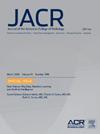Prevalence of Health-Related Social Needs and Associated Missed Imaging Appointments Among Patients With Cancer
IF 5.1
3区 医学
Q1 RADIOLOGY, NUCLEAR MEDICINE & MEDICAL IMAGING
引用次数: 0
Abstract
Purpose
Health-related social needs (HRSNs) lead to health disparities and impact cancer care, but their link with missed imaging appointments in patients with cancer is unclear. We assessed screen rate and prevalance of HRSNs and their association with missed imaging appointments among patients with cancer.
Methods
Patients aged ≥18 years with cancer who completed an oncology wellness form as part of usual care between January 1, 2022, and September 30, 2023, who had an imaging examination scheduled at the same health system within 3 months after form completion were included. The form assessed HRSNs (financial, transportation, and housing) and patients’ preference for written or verbal information about HRSNs services. Multivariable regression models evaluated the association between HRSNs and missed imaging appointments.
Results
In all, 3,495 (16.6%) of patients had a completed oncology wellness form during 3,964 (4.3%) encounters; of those, 2,890 had imaging scheduled in the next 3 months and were included (mean age: 61.6 ± 15.9 years; 50.2% female; 20.1% Asian, 2.8% Black, 57% White, 20.6% Hispanic). HRSNs were reported during 22.9% of encounters, with 82.9%, 40.2%, and 37.5% of reported HRSNs being due to financial hardship, transportation, and housing issues. Only 6.5% and 4.4% of encounters positive for HRSNs reported a desire for written information or to speak with someone about their HRSNs, respectively. At least one imaging encounter was missed by 70% in the subsequent 3 months. Adjusting for sociodemographic factors, patients reporting HRSNs were more likely to miss their imaging appointment (odds ratio, 1.29; 95% confidence interval, 1.03-1.61).
Conclusion
Patients with cancer with self-reported HRSNs tend to have higher missed imaging appointments.
癌症患者中与健康相关的社会需求的患病率及相关的影像预约遗漏
目的:与健康相关的社会需求(HRSNs)导致健康差异并影响癌症护理,但其与癌症患者错过影像学预约的关系尚不清楚。我们评估了HRSNs的筛查率和患病率,以及它们与癌症患者错过影像预约的关系。方法:纳入年龄≥18岁的癌症患者,这些患者在2022年1月1日至2023年9月30日期间完成了肿瘤健康表,作为常规护理的一部分,并在完成表格后3个月内在同一卫生系统进行了影像学检查。该表格评估了HRSNs(财务、交通和住房)以及患者对HRSNs服务的书面或口头信息的偏好。多变量回归模型评估了HRSNs与错过影像预约之间的关系。结果:总共有3,495(16.6%)名患者在3,964(4.3%)次就诊中填写了完整的肿瘤健康表;其中2,890例患者在未来3个月内接受影像学检查(平均年龄:61.6±15.9岁;50.2%的女性;20.1%亚裔,2.8%黑人,57%白人,20.6%西班牙裔)。22.9%的患者报告了HRSNs,其中82.9%、40.2%和37.5%的HRSNs是由于经济困难、交通和住房问题造成的。分别只有6.5%和4.4%的HRSNs阳性患者表示希望获得书面信息或与他人谈论他们的HRSNs。在随后的3个月里,至少有一次成像失检率为70%。调整社会人口因素后,报告HRSNs的患者更有可能错过影像学预约(优势比,1.29;95%置信区间为1.03-1.61)。结论:自报HRSNs的癌症患者往往有较高的影像学漏诊率。
本文章由计算机程序翻译,如有差异,请以英文原文为准。
求助全文
约1分钟内获得全文
求助全文
来源期刊

Journal of the American College of Radiology
RADIOLOGY, NUCLEAR MEDICINE & MEDICAL IMAGING-
CiteScore
6.30
自引率
8.90%
发文量
312
审稿时长
34 days
期刊介绍:
The official journal of the American College of Radiology, JACR informs its readers of timely, pertinent, and important topics affecting the practice of diagnostic radiologists, interventional radiologists, medical physicists, and radiation oncologists. In so doing, JACR improves their practices and helps optimize their role in the health care system. By providing a forum for informative, well-written articles on health policy, clinical practice, practice management, data science, and education, JACR engages readers in a dialogue that ultimately benefits patient care.
 求助内容:
求助内容: 应助结果提醒方式:
应助结果提醒方式:


